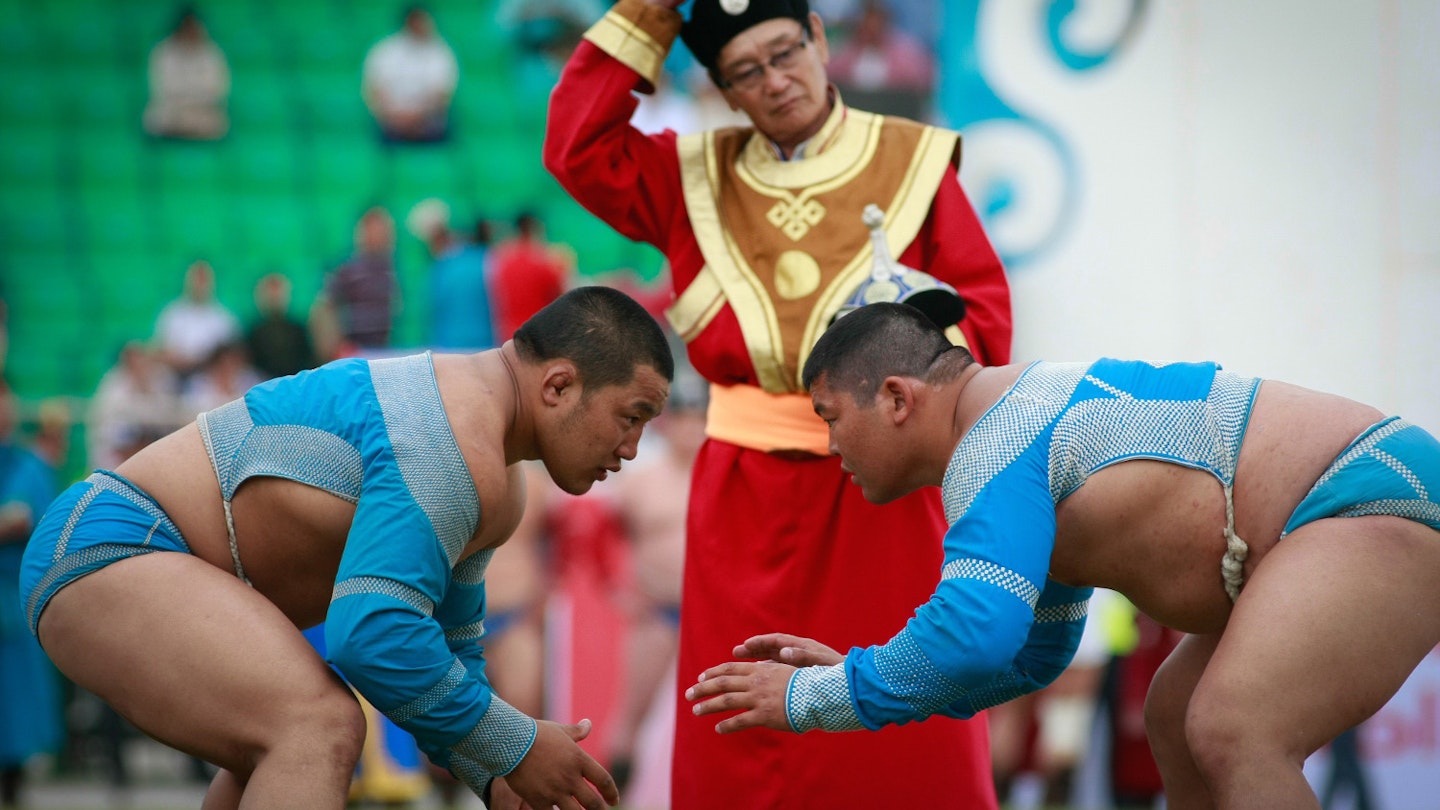Sequinned revellers, shiny pants, pilgrimages, and historic towns – July certainly has a lot in store for the culture-conscious traveller.
Between Antigua’s crazy carnival, Mongolia’s ‘manly arts’, high-diving off Bosnia Herzegovina’s infamous bridge, action abounds; however, a little peace and reflection can also be found, as July is prime time for climbing Japan’s iconic Mount Fuji.
See men wrestling in shiny pants in Mongolia
Ulaanbataar is the world’s coldest capital, making winter visits less advisable. Although spring and autumn can be brisk across the Central Asian steppe, July is Mongolia’s hottest month, reaching temperatures of 30°C (86°F) in some areas, particularly in the Gobi Desert. It’s worth braving this heat to witness Mongolia’s hottest spectacle: Naadam.
Held from July 11 to 13, this festival showcases ‘manly arts,’ including horse racing, archery, and wrestling contests. Nomadic families converge on the capital, bringing with them parades and traditional games that utilize shagai (the ankle bones of sheep). This presents a fascinating insight into Mongolian culture. Additionally, Ger camps in the southern Gobi are open for visitors during this time. For those looking to escape the extreme heat, consider exploring the Mongol ruins of Karakorum or the cooler northern Lake Khövsgöl, ideal for boating, hiking, and encounters with reindeer herders.
-
Trip plan: Start in Ulaanbaatar. In two weeks, you could fly south to Dalanzadgad (Gobi) and travel north by 4WD to Lake Khövsgöl, discovering dunes, dinosaur fossils, and ancient ruins along the way. Fly back to Ulaanbaatar from Mörön.
-
Need to know: The Trans-Mongolian train between Moscow and Běijīng makes stops at Ulaanbaatar.
-
Other months: May-Oct – warm/hot (Jul-Aug: busiest); Nov-Apr – bitterly cold.
Make a pilgrimage up Japan’s favorite peak
Nothing looms larger in the Japanese psyche than Mt Fuji. This perfectly conical 12,388ft (3,776m) volcano is considered sacred, and it even features on the ¥1000 note. During official climbing season, from July 1 to September 14, when trails are free of snow and facilities open, locals flock here in droves. While trekking up Fuji during this time might be busy, it also serves as a cultural experience. The interactions with fellow climbers add to the journey, especially when purchasing fizzy drinks from path-side vending machines.
Standing at the summit at dawn to witness the goraiko (arrival of the light) is a moving experience, regardless of how large the crowds may be. Moreover, July offers pleasant weather across the country, making it an excellent time to immerse yourself in Kyoto’s vibrant Gion Matsuri festival, where 10-tonne floats parade through the historic streets.
-
Trip plan: Explore Tokyo, then head south to Hakone for access to Fuji. Afterward, explore Kyoto and take the bullet train back to Tokyo.
-
Need to know: Public transport services trailheads part-way up Mt Fuji; there are four routes to the summit.
-
Other months: Jul–mid-Sep – climbing season; Sep-Oct – fall colors; Nov-Mar – cold, snow; Mar-Apr – cherry blossom; May-Jun – warm.
Head to Antigua for carnival madness – and a bit of sunshine
Hurricane season in the Caribbean typically lasts from July to November, but the worst storms are usually reserved for the later months. Therefore, consider heading to Antigua now for hopefully hot, sunny, and largely dry weather. The island boasts numerous beaches—though claiming 365 may be an exaggeration—there are still plenty of palm-fringed spots and rum-serving beach bars to enjoy.
Don’t forget to explore cultural sites like the unique Georgian-era Nelson’s Dockyard, where Admiral Nelson served, and experience a cricket game (the national sport). Additionally, July marks Antigua’s grand summer Carnival, featuring soca music, steel bands, vibrant parties, and lively parades. Grab a Wadadli beer, put on your most comfortable shoes, and join the festivities.
-
Trip plan: For a more peaceful visit, avoid the end of July, as the main Carnival period typically runs from late July into early August. Plan to stay a week to savor both snorkeling and scenic drives along Antigua’s volcanic hills.
-
Need to know: The turtle nesting season occurs from June to November.
-
Other months: Dec-Apr – dry, cool; May-Jun – hotter; Jul-Nov – hurricane season (worst in Aug-Oct).
Explore two sun-soaked, history-packed cities in Bosnia Herzegovina
Stari Most, the iconic stone bridge over Mostar’s Neretva River, symbolizes Bosnia Herzegovina. Originally constructed by the Ottomans in the 16th century, this bridge reflects the country’s rich East-meets-West heritage. While it was destroyed in 1993, its reconstruction in 2004 stands as a symbol of peace and unity, and it serves as a launch pad for those brave enough to dive 69ft (21m) into the water below.
Bridge jumps take place throughout the summer, but it is at the end of July that thousands gather for the Ikari, the world’s longest-running high-dive competition. Watching these daring feats can be exhilarating. Alternatively, wander through the charming, labyrinthine Old Town. Combine your visit to Mostar with a trip to Sarajevo, where Ottoman architecture and Arabian-style bazaars coexist alongside the remnants of communist blocks, still marked by 20th-century warfare. While reflecting on the city’s tragic past, the fun-loving nature of Sarajevo’s people and its hidden underground bars can uplift the spirit.
-
Trip plan: Spend a few days in each city. The drive from Mostar to Sarajevo takes approximately 2½ hours through the mesmerizing Neretva Canyon.
-
Need to know: Mostar is accessible by bus from Dubrovnik, which takes around three hours.
-
Other months: Jun-Sep – hot; Mar-May & Oct-Nov – quieter, cool, flowers/fall colors; Dec-Feb – snow, skiing.




